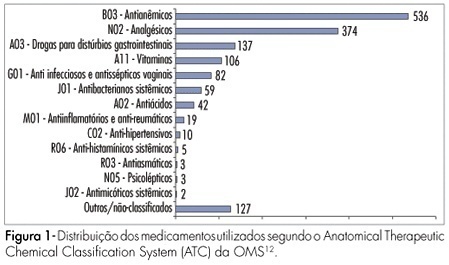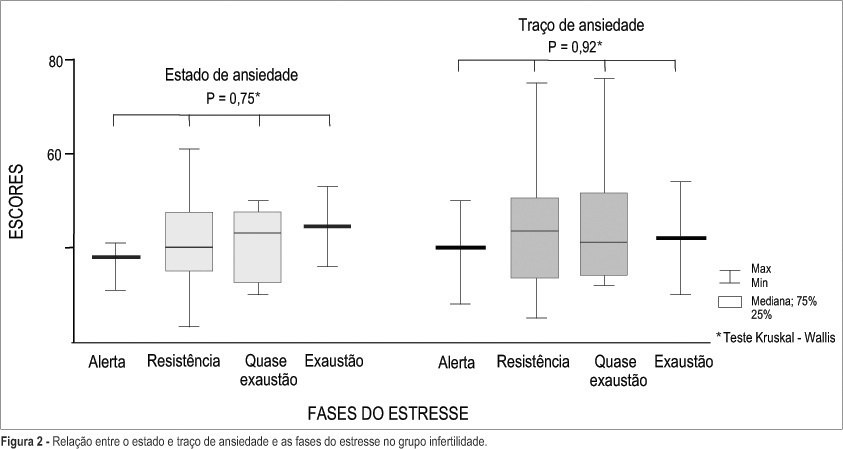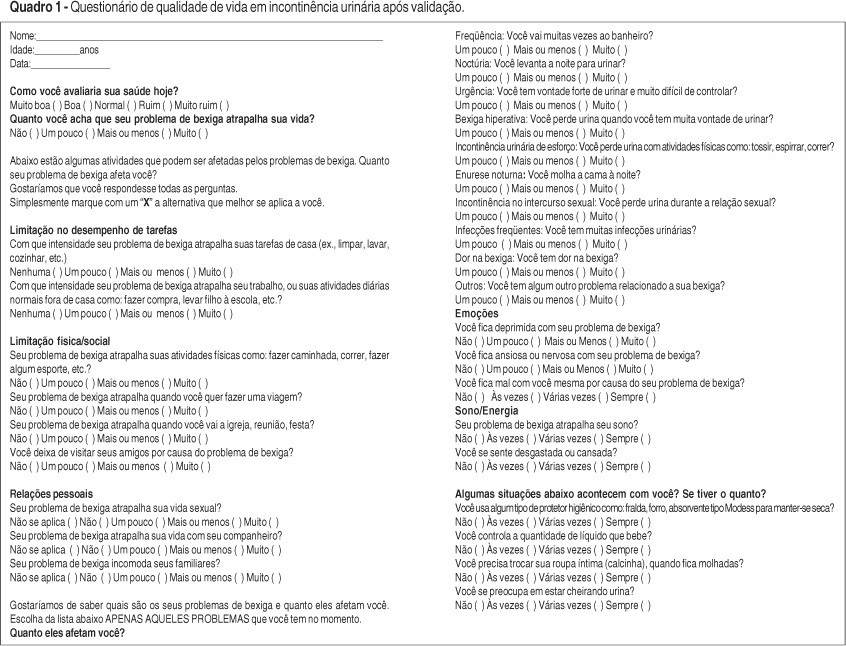Summary
Revista Brasileira de Ginecologia e Obstetrícia. 2008;30(8):384-392
DOI 10.1590/S0100-72032008000800003
PURPOSE: the objective of the present study was the development of the Brazilian Portuguese version of Endometriosis Health Profile Questionnaire (EHP-30), the cross-cultural adaptation to Brazil and the evaluation of EHP-30 Portuguese psychometric measures in a Brazilian sample. METHODS: the original instrument in English was translated into Portuguese following international guidelines, going through all stages of translation, back-translation and comparison of the versions for cross-cultural adaptation, face and content validity. A sample of 54 patients with endometriosis was used for internal consistency analyses using the Cronbach alpha. Test-retest reliability was evaluated through the intraclass correlation coefficient (ICC). In order to evaluate the convergent construct validity, the correlation between EHP-30 Portuguese and WHOQOL-Bref and Beck Depression Inventory (BDI) was tested. RESULTS: internal consistency presented alpha values of 0.8 to 0.9 suggesting homogeneity between questions. The test-retest reliability presented ICC of 0.8 to 0.9 showing instrument stability. In the construct validation, strong correlations were demonstrated of the EHP-30 Portuguese self-image scale with physical (-0.6) and psychological domains (-0.6) of WHOQOL-Bref, and EHP-30 Portuguese social support scale with BDI (0.5), confirming good correlation with other quality of life evaluation instruments. CONCLUSIONS: the EHP-30 Portuguese was found to be an easy, quickly applied instrument, and well-accepted by the patients. It presented good psychometric properties with appropriate reliability measures (internal consistency and test-retest reliability) and construct validity. These results show that EHP-30 Portuguese is an adequate instrument for quality of life evaluation in Brazilian women with endometriosis, both in clinical and research setting.

Summary
Revista Brasileira de Ginecologia e Obstetrícia. 2008;30(1):12-18
DOI 10.1590/S0100-72032008000100003
PURPOSE: to study the use of medicines by pregnant women during prenatal care in clinics of the national public health system in the city of Natal, Brazil. METHODS: a total of 610 pregnant women between the first and the third trimesters of pregnancy were interviewed in the public clinics of the four sanitary districts of Natal, from May to July 2006. The data were collected by a structured questionnaire, based in use-oriented and medicine-oriented questions. The drugs were classified according to the Anatomical Therapeutic Chemical Classification System (ATC), in agreement with the gestation risk criteria from the Food and Drugs Administration (FDA). The statistical analysis was made by the chi2 test. RESULTS: a total of 1,505 drugs were used, with an average of 2.4 medications per woman. The use of at least one drug was found in 86.6% of the women. The most frequently used drugs were anti-anemics (35.6%), analgesics (24.9%), drugs for gastrointestinal disorders (9.1%) and vitamins (7%). According to the FDA classification, 42.7% belonged to category A risk, 27.1% to category B, 29.3% to category C, 0.3% to category D and none to category X. The use of medicines during the first trimester of pregnancy amounted to 43.6%. The rate of drug use increased with higher schooling level and family income. Self-medication was found in 12.2% of the drug intake and this rate was higher in the first trimester of gestation and with women with low education level and previous gestations. CONCLUSIONS: pregnant women from Natal are being exposed to a variety of medicines with uncertain safety in pregnancy. Therefore, more careful prescription is needed, to avoid possible fetal damage.

Summary
Revista Brasileira de Ginecologia e Obstetrícia. 2008;30(3):121-126
DOI 10.1590/S0100-72032008005000002
PURPOSE: to compare the frequency of vulvovaginitis in women infected with human imunnodeficiency virus (HIV) with the frequency in non-infected women. METHODS: a transversal study including 64 HIV infected women and 76 non-infected ones. The frequencies of bacterial vaginosis, candidiasis and trichomoniasis, diagnosed by Amsel's criteria, culture and fresh exam, respectively, were calculated. Chi-square test, Fisher's exact test and multiple regressions to verify the independence of associations were used to analyze the data. RESULTS: the vaginal infection was more prevalent in HIV infected patients, as compared to the control group (59.4 versus 28.9%, p<0,001; Odds Ratio=2.7, IC95%=1.33-5.83, p=0.007). Bacterial vaginosis occurred in 26.6% of the positive-HIV women; vaginal candidiasis, in 29.7% and trichomoniasis, in 12.5% of them. All the infections were significantly more frequent in the group of HIV infected women (p=0.04, 0.02 e 0.04, respectively). CONCLUSIONS: vulvovaginitis is more frequent in HIV infected women.
Summary
Revista Brasileira de Ginecologia e Obstetrícia. 2007;29(8):396-401
DOI 10.1590/S0100-72032007000800003
PURPOSE: to translate and to validate the Female Sexual Function Index (FSFI) for Brazilian pregnant women. METHODS: ninety-two pregnant women attended at a low risk prenatal clinic, with diagnosis of the pregnancy confirmed by precocious ultrasonography, participated in the research. Initially, we translated the FSFI questionnaire for Portuguese language (of Brazil) in agreement with the international criteria. Cultural, conceptual and semantics adaptations of FSFI were accomplished, because of the differences of the language, so that the pregnant women understood the subjects. All the patients answered FSFI twice, in the same day, with two different interviewers, with an hour interval from one to other interview. After 7 to 14 days, the questionnaire was applied again in a second interview. Reliability (internal intra and interobserver consistence) and the validity of the constructo (to demonstrate that questionnaire measures the sexual function) were appraised. RESULTS: Cultural adaptations were necessary for us to obtain the final version. The internal intra-observer (alpha of Chronbach) consistence of the several domains oscillated from moderate to strong (0,791 to 0,911) and the interobserver consistence varied from 0,791 to 0,914. In the validation of the constructo, were obtained moderate correlations to fort among the final scores (general) of FSFI and of Female Sexual Quotient (QS-F) that has the capacity to evaluate the feminine sexual function. CONCLUSIONS: FSFI was adapted to the Portuguese language and to the Brazilian culture, presenting significant reliability and validity; it could be included and used in future studies of the Brazilian pregnant sexual function.
Summary
Revista Brasileira de Ginecologia e Obstetrícia. 2006;28(6):358-364
DOI 10.1590/S0100-72032006000600007
PURPOSE: to assess the frequency of stress and anxiety levels in infertile women, in order to obtain data for specific psychological intervention. METHODS: a cross-sectional study involving 152 infertile (mean age 30.3±5.4 years), and 150 healthy control women (25.7±7.9 years). All patients were evaluated with the Lipp's Inventory of Stress Symptoms and the State-Trait Anxiety Inventory. Considered dependent variables were: stress frequency and anxiety scores (state and trait). Statistical analysis was performed by the chi2 and Mann-Whitney tests, and logistical regression to test associations between response variables and considered risk factors. Statistical significance was defined as p<0.05. RESULTS: the stress was more frequent in the infertile group than in the control group (61.8 and 36.0%, respectively); however, no significant differences were observed between groups in relation to stress phases and predominant symptoms. With respect to anxiety, there were no significant differences between infertile and control groups as to median state scores (39.5 and 41.0, respectively) and anxiety trait scores (44.0 and 42.0, respectively). Factors significantly associated with greater risk for high anxiety scores in the infertile group were: unawareness of the causal factor, diagnostic phase investigation, and lack of children from other marriages. CONCLUSIONS: it can be concluded that infertile women are more vulnerable to stress; however, they are capable of adapting themselves to stressful events without serious physical or psychological compromise.

Summary
Revista Brasileira de Ginecologia e Obstetrícia. 2005;27(5):235-242
DOI 10.1590/S0100-72032005000500002
PURPOSE: the proposal of the present study was to translate and to validate King's Health Questionnaire (KHQ) for Brazilian women with urinary incontinence. METHODS: a hundred and thirty-four patients with urinary incontinence, confirmed by urodynamic study, were enrolled from the outpatient clinic of Uroginecology. Initially, we translated the KHQ into the Brazilian Portuguese language in agreement with international criteria. Due to language and cultural differences we performed a cultural, structural, conceptual, and semantic adaptation of the KHQ, in order to make sure that patients were able to fully understand the questions. All patients answered the KHQ twice on the same day, within an interval of 30 min, applied by two different interviewers. After 7 to 14 days, on a second visit, the questionnaire was applied again. Reliability (intra- and interobserver internal consistency), construct and discriminative validity were tested. RESULTS: several cultural adaptations were necessary until we reached the final version. The intra-observer internal consistency (alpha of Cronbach) of the several dimensions varied from moderate to high (0.77-0.90), and the interobserver internal consistency varied from 0.66 to 0.94. Moderate to strong correlation was detected among the specific KHQ urinary incontinence dominions and clinical urinary incontinence manifestations known to affect the quality of life of these patients. CONCLUSION: KHQ was adapted to the Portuguese language and to the Brazilian culture, showing great reliability and validity. It should be included and used in any Brazilian urinary incontinence clinical trial.
